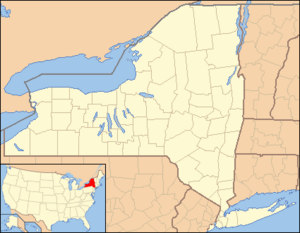Alcove, New York facts for kids
Quick facts for kids
Alcove
|
|
|---|---|
| Motto(s):
Here comes the rush
|
|

Location of Alcove within New York
|
|
| Country | United States |
| State | New York |
| Region | Capital District |
| County | Albany |
| Elevation | 545 ft (166 m) |
| Population
(1994)
|
|
| • Total | appr. 300 |
| Time zone | UTC-5 (EST) |
| • Summer (DST) | UTC-4 (EDT) |
| Postal code |
12007
|
| Area code(s) | 518 |
Alcove is a small community, called a hamlet, located in the town of Coeymans, Albany County, New York, United States. It's a great example of a 19th-century mill town. This means it grew up around factories that used water power. Because of its history, Alcove is listed on the National Register of Historic Places. This list helps protect important historical sites. The Alcove Reservoir, a large lake that supplies water to the city of Albany, is located just west of the hamlet.
Contents
History of Alcove

The story of Alcove is closely tied to the mills built along the Hannacrois Creek. In 1790, an early settler named Casperus Ackerman built the very first mill here. Later, in 1844, Ephraim Andrews started the Valley Mill. This mill was used for processing wool and making cloth.
The mill was expanded in 1848 and changed to make straw paper. In 1854, new improvements like steam power were added. The Briggs family took over the mills in 1871. They even bought other local mills. Alcove was once called Stephensville, named after Archibald Stephens, who owned a mill before the Briggs family.
The hamlet got its current name, Alcove, in 1881 when a post office was opened there. Sadly, the Valley Mill was destroyed by a fire in 1892. All that was left was its tall, 110-foot chimney. This chimney is now on the National Register of Historic Places. It's part of the Alcove Historic District, which was created in 1980. This district includes about 140 acres of the hamlet and eight important historical buildings. A group called the Alcove Preservation Association is working to restore the chimney. They hope to create a small park and a history center there.
The Alcove Reservoir was built between 1928 and 1931. It was made by building a dam across the Hannacrois Creek. This project caused the nearby hamlet of Indian Fields to be flooded and destroyed. The cemetery from Indian Fields was moved to NY 143, at the northern edge of Alcove.
Geography of Alcove
Alcove is located along the Hannacrois Creek, just east of the Alcove Reservoir. Sometimes, during dry periods, the city of Albany doesn't release water from the reservoir. This can cause the Hannacroix Creek to dry up for a few miles downstream from the dam.
To the east of Alcove are Coeymans Hollow and the village of Ravena. To the south is Greene County. The hamlet is centered where Albany County Route 111 and Alcove Road meet. It also stretches north along Albany County Route 111 to New York State Route 143.
Where is Alcove?
 |
 |
|||
| Alcove Reservoir | Hamlet of Coeymans Hollow | |||
| Greene County |
Architecture in Alcove
Many of the older homes in Alcove are built from a special type of stone called Alcove bluestone. You can see a large smokestack on Albany County Route 111. This smokestack was once part of a big mill that is no longer there. It is also listed on the National Register of Historic Places. There's also an old one-room schoolhouse in the hamlet. It used to serve the children of Alcove, but now it's a private home.
Education in Alcove
Children in Alcove attend schools within the Ravena-Coeymans-Selkirk Central School District (RCS). Younger students, from kindergarten through fifth grade, go to Pieter B. Coeymans Elementary School. Older students, from sixth through twelfth grade, attend Ravena-Coeymans-Selkirk High School.
Transportation in Alcove
New York State Route 143 (NY 143) is an important road for Alcove. It connects the hamlet to other main communities in the town of Coeymans. These include Coeymans Hollow, Aquetuck, Ravena, and Coeymans. NY 143 also links Alcove to major highways like US Route 9W and the Governor Thomas E. Dewey Thruway (I-87).
Historic location
- Valley Paper Mill Chimney and Site


